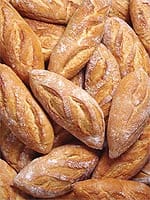Life Extension Magazine®
The most significant anti-aging discovery in history was made in 1935. In that year, rats fed a calorie restricted diet achieved radically-extended mean and maximum life spans, along with a delayed onset of age-related diseases.1 Since this finding was published 75 years ago, dozens of experiments in mammals have validated that undernutrition without malnutrition induces profound anti-aging effects.2-10 Not only do calorie restricted animals live much longer, but they remain far healthier than normally-fed controls. When a group of humans consumed a similar calorie restricted diet, their conventional blood markers of aging (excess glucose, cholesterol, triglycerides, LDL) plummeted to much lower levels.11,12 In the most significant finding to date, two groups of Rhesus monkeys were studied for twenty years. The group placed on a moderately restricted diet reduced their incidence of age-related disease by a factor of three! Cancers and cardiovascular disease were less than half in the moderate calorie restricted group compared to controls. None of the moderate calorie restricted group developed diabetes or impaired glucose tolerance, despite a usually high prevalence in these monkeys. An interesting finding showed that moderate calorie reduction preserved brain volume in certain regions.13 Normal aging is accompanied by brain shrinkage as neurons are lost.
This issue of Life Extension® is dedicated to providing practical options to attain many of the beneficial effects of calorie restriction. Our objective is to help induce the favorable changes in our members’ bodies that may be responsible for the remarkable age-delaying and disease-protecting effects of reduced calorie intake. A Time to Make Personal CommitmentsAfter reading this article, I hope each of you will reduce some of the excess calories you ingest each day. I can almost promise that if you do it right, you’ll never miss these surplus age-accelerating sugars and fats. Even if you are unable to cut a single calorie, we are going to show how you can benefit nonetheless. A study of those making New Year’s resolutions showed that 46% are compliant after six months.14 During this time of year, when people strive for a healthier and longer life, I believe most of you will succeed in cutting back at least some excess food intake. We All Eat Too MuchCalorie-dense toxic foods are abundant, cheap and heavily advertised. It is no wonder that so many children and adults eat far more than what their bodies require. Excess calorie intake causes our bloodstream to be chronically ‘bloated’ with glucose, insulin, cholesterol, fat, homocysteine, and other pro-inflammatory inducers. Persistent bloodstream overload predisposes us to cancer, stroke, heart attack, senility, painful inflammation and virtually every other age-related ailment.15-27 Consuming excess calories shortens our average life span by facilitating the development of age-related diseases that preclude us from attaining healthy longevity. Overconsumption of calories has another insidious effect. Many scientists believe that our life span is largely controlled by genes that program our bodies to function in a youthful-healthy state. When we consume excess calories, we cause some of these genes to turn against us and contribute to accelerated aging and death. If we reduce the amount and/or effects of ingested calories, the result is a more favorable gene expression profile. Such a positive effect helps us to live longer, healthier lives. Controlling the impact of ingested calories becomes an essential component of a science-based longevity program, as excess calorie exposure reduces life span by increasing degenerative disease risk and accelerating aging. So now that you understand that most of us are eating too much, let’s talk about practical approaches to doing something about it. Reduce the Number of Calories You Absorb
Foods eaten must first be broken down by digestive enzymes before they are absorbed into our bloodstream. Dietary fats, for instance, are broken down by lipase enzymes in the stomach and small intestines. Taking 120 mg of the lipase-inhibiting drug orlistat before meals reduces dietary fat absorption by 30%.28 Green and black tea polyphenols also inhibit lipase, thus enabling one to eat more calories without absorbing all of the fats.29,30 In fact, when theaflavins from black tea were administered to rats, there was an immediate suppression of post-meal (postprandial) triglyceride elevation in the blood. The scientists attributed these results to the “inhibition of pancreatic lipase activity.”30 You might think that a drug like orlistat that reduces fat absorption by 30% would induce significant weight loss. The harsh reality is that study subjects must reduce their dietary fat intake and take orlistat to lose just 20.5 pounds in one year. These data reveal the frightening degree to which most of us overeat.31 In other words, even when dietary fat absorption is reduced by 30%, we still take in too many fat calories. Studies show that in response to consumption of green or black tea polyphenols (or orlistat), substantial reductions in blood glucose, triglycerides, cholesterol, and other vascular risk factors occur.32-41 These same changes happen when one reduces calorie intake,11,12 suggesting that those who continue to eat too much should take steps to block digestive enzymes that enable excess calories to be absorbed. Most Western diets contain too many refined carbohydrates that add to the calorie burden. Ingested carbohydrates are broken down for absorption by the enzymes sucrase, amylase, and glucosidase. One may obtain some of the effects of following a “low-carb” diet by taking 50-100 mg of a drug called acarbose (glucosidase inhibitor) before each meal.42,43 Nutrients that may slow carbohydrate absorption include white kidney bean (amylase inhibitor),44-47 InSea™ (containing amylase and glucosidase inhibitors from special seaweeds),48-51 Irvingia (amylase inhibitor)52-55 and L-arabinose (sucrase inhibitor).56 These carbohydrate-blunting nutrients are all contained in the new Optimized Irvingia formula. Clinical studies confirm significant reductions in glucose, insulin, and triglyceride levels in response to taking acarbose alone.57-59 These effects also occur when one restricts their calorie intake. Clinical studies show dramatic reductions in heart attack rate in response to acarbose.59 This same kind of vascular disease risk reduction has been observed in experimental studies where food intake is restricted.60-62 What this indicates is that one may obtain some of the benefits of following a calorie restricted diet by inhibiting lipase, amylase, glucosidase, and sucrase enzymes. Consuming soluble dietary fibers before meals slows the absorption of carbohydrates, thus blunting the postprandial insulin spike.63-66 This is another method of impeding calorie absorption and helping to mimic the effects of calorie restriction. Improve Your Gene ExpressionIn response to consuming fewer calories, gene expression favoring youthful vigor is improved. Overeating, on the other hand, induces pathologic gene expression favoring the onset of diseases and accelerated aging.72,73
Until recently, the only way of achieving a favorable gene expression profile was through caloric restriction. Back in the late 1990s, research funded by the Life Extension Foundation® enabled scientists to compare the effects of various compounds (such as resveratrol) to the gene expression changes that occur during calorie restriction. These experiments have been used to identify nutrients that mimic many of the beneficial gene expression changes observed during calorie restriction. As you will read in this month’s issue, many of the nutrients Life Extension® members have been taking for decades, and a few new ones, favorably influence gene expression changes that occur during calorie restriction. Once scientists gain total control over the expression of the genes that affect longevity, mankind may achieve biological immortality.Until that time arrives, it is comforting to know that we can now exert at least some control over the expression of genes that influence our health and longevity. With the discovery of novel plant extracts that mimic some of the gene expression changes observed in response to calorie restriction, one may enjoy many of the longevity benefits of undereating by taking the proper supplements daily. Moderate Calorie Restriction—It’s Not as Difficult as You Think!For too many people, copious food intake has become an addictive drug. I am so gratified that the nutrient Irvingia and the drug metformin keep my appetite under control and enable me to eat a lot less than I used to. There are other nutrients and drugs that effectively curb appetite, but these are all I have needed. I don’t miss gorging on surplus calories. One reason is my regular review of scientific articles that discuss reasons why people develop lethal diseases. For many medical conditions, overeating (described as “excess energy intake”) is an independent risk factor for developing anything from cancer, to vascular disease, to arthritis, and even to senility.74-79 I regularly speak with individuals who practice what many would say is extreme calorie restriction. The media views these individuals as being so unique that they have been favorably featured on CBS News’ 60 Minutes, the Oprah Winfrey Show, and in Newsweek magazine. When I asked two of the most famous calorie restrictors how many calories they consume a day, Paul McGlothin told me he eats around 1,900, while Meredith Averill’s intake is around 1,600 daily. Based on these numbers, I did not think Paul or Meredith are overly depriving themselves. People who go on crash diets, sometimes consuming fewer than 1,000 calories a day, are absolutely miserable, and rapidly regain the weight they lost. Paul and Meredith, on the other hand, say they are activating their “happiness biochemistry” and would never consider eating more food that would compromise their mental state of well being and physical state of health.
At the beginning of this article I described the Rhesus monkey study that utilized only modest calorie restriction to achieve remarkable longevity benefits. From everything we know today, it would appear that many of you could migrate towards a routine of at least modest calorie reduction and feel better doing so. So much of our appetite craving is psychological. I was at a business dinner a while back and ordered an 8-ounce filet mignon. When I finished, I thought that I should have ordered a larger portion. Several nights later, I ordered a 12-ounce size at the same restaurant and felt uncomfortably full. This made me realize how we “think” we need large portions of food to be satiated, when we really don’t. (I rarely eat beef by the way, usually only small portions a few times a month.) It is hard for me to dine with regular people and not be appalled by the enormous amount of calories they ingest at a single meal. I know I feel better at the meal’s conclusion, while these individuals are bloated from gorging themselves with so many excess calories. Once one accepts the fact that surplus food ingestion is poison to the body, it’s a lot easier to practice at least a moderate degree of caloric cutback.
| |||||||||||
Practical Options to Emulate Calorie Restriction
The scientific data solidly document that surplus calorie intake shortens your life span.87,88 Everyone responds differently when reducing food intake, but most people can at least modestly decrease the number of calories they consume each day. Most individuals, however, will still eat more than they should. Fortunately, there are multiple ways to inhibit the activity of digestive enzymes, and thus spare most of the body from the lethal effects of excess calorie absorption. An aggressive three-month plan to reduce the number of absorbed calories involves taking the following nutrients and drugs before most meals:
For some individuals, drugs like orlistat that inhibit lipase will cause gastrointestinal discomfort after eating too much. One objective of suggesting a 90-day trial using this drug is to forcibly educate you about healthier lifelong dietary patterns. For example, if you continue to consume excess fat calories and take orlistat, the result will be lots of lipid-laden feces in the toilet after a bowel movement. Understanding that this fat appearing in your toilet was destined to be absorbed into your bloodstream (which could shorten your life span) may motivate you to eat less. Likewise, digestive discomfort associated with excess carbohydrate intake in the presence of alpha-glucosidase, amylase, and sucrase inhibitors may entice you to reduce intake of dangerous simple carbohydrates. In case you have not figured this out yet, a side benefit to doing all this is a loss of surplus body fat.
To mimic some of the favorable gene expression changes that occur in response to calorie restriction, a new nutrient formula called Calorie Restriction Mimetic Formula has been developed that consists of the following nutrients in the daily dose:
These and a number of other nutrients that health-conscious people already take, such as high dose vitamin D3 and fish oil, have been shown to favorably alter gene expression.89-101 We Live in an Exciting Era!Scientists continue to validate the health benefits of nutrients that Life Extension members supplement with every day. Only recently, however, have these favorable effects been linked to the ability of these nutrients to mimic gene expression changes that occur in response to calorie restriction.72, 101-105 An explosive volume of newly published research indicates that aging humans can exert tremendous degrees of control as to whether they maintain youthful or senescent gene expression patterns in their cellular DNA.106-108
Some youthful gene expression can be maintained by reducing intake of calories to a level 20-40% lower than is typical, while still obtaining all the necessary nutrients and vitamins.13,109-113 The most recent study indicates even a modest calorie restricted diet produces huge reductions in degenerative disease in monkeys.13 Those who are unable to sufficiently cut their food intake can still inhibit the absorption of ingested calories by taking compounds (such as orlistat, acarbose, and/or the new Optimized Irvingia formula) that block digestive enzyme activity. Finally, and most exciting of all, there are nutrients (such as pterostilbene and resveratrol) that have been shown to mimic many of the favorable effects induced by calorie restriction.102-104,114-116 These low-cost nutrients provide humans with an unprecedented power to determine whether their cellular DNA expresses youth-promoting or senescent-inducing genes. Humans have never enjoyed so much control over the rate that they age! Advanced Nutritional Formulas at the Year’s Lowest PricesFor more than two decades, Life Extension members have taken advantage of the annual Super Sale to acquire their favorite nutrient formulations. Life Extension upgrades its formulas almost every year to provide more effective health-sustaining nutrients. In the last few months, we introduced a new form of ubiquinol CoQ10 that is significantly better absorbed into the cell’s mitochondria, standardized apigenin to maintain healthy cell division, and a novel plant compound that protects against persistent inflammatory joint conditions. In this month’s issue, you’ll learn about nutrients that help arouse youthful gene expression changes, along with a new carbohydrate blocker (sucrase) that diminishes the amount of unwanted glucose absorbed into your bloodstream. Every time you purchase a Life Extension® product, you contribute to research aimed at radically extending the healthy human lifespan. Last year, the Life Extension Foundation funded a record number of scientific projects. During the traditional winter Super Sale, all Life Extension formulas are discounted so that members can obtain up-to-date versions at the lowest prices of the year. For longer life,
William Faloon | |||||||||||||||
| References | |||||||||||||||
| 1. McCay CM, Crowell MF, Maynard LA. The effect of retarded growth upon the length of life span and upon the ultimate body size. 1935. Nutrition. 1989 May-Jun;5(3):155-71. 2. Weindruch R, Walford RL. Dietary restriction in mice beginning at 1 year of age: effect on life span and spontaneous cancer incidence. Science. 1982 Mar 12;215(4538):1415-8. 3. Weindruch R, Walford RL, Fligiel S, Guthrie D. The retardation of aging in mice by dietary restriction: longevity, cancer, immunity and lifetime energy intake. J Nutr. 1986 Apr;116(4):641-54. 4. Raffoul JJ; Guo Z; Soofi A; Heydari AR. Caloric restriction and genomic stability. J Nutr Health Aging. 1999;3(2):102-10. 5. Roth GS, Ingram DK, Black A, Lane MA. Effects of reduced energy intake on the biology of aging: the primate model. Eur J Clin Nutr. 2000 Jun;54 Suppl 3:S15-20. 6. Lane MA, Ingram DK, Roth GS. Nutritional modulation of aging in nonhuman primates. J Nutr Health Aging. 1999; 3(2):69-76. 7. Weed JL, Lane MA, Roth GS, Speer DL, Ingram DK. Activity measures in rhesus monkeys on long-term calorie restriction. Physiol Behav. 1997 Jul;62(1):97-103. 8. Hsieh EA, Chai CM, Hellerstein MK. Effects of caloric restriction on cell proliferation in several tissues in mice: role of intermittent feeding. Am J Physiol Endocrinol Metab. 2005 May;288(5):E965-72. 9. Weindruch R. Effect of caloric restriction on age-associated cancers. Exp Gerontol. 1992 Sep-Dec;27(5-6):575-81. 10. Weindruch R. Dietary restriction, tumors, and aging in rodents. J Gerontol. 1989 Nov;44(6):67-71. 11. Martins C, Morgan LM, Robertson MD. Effects of restrained eating behaviour on insulin sensitivity in normal-weight individuals. Physiol Behav. 2009 Mar 23;96(4-5):703-8. 12. Lefevre M, Redman LM, Heilbronn LK, et al. Caloric restriction alone and with exercise improves CVD risk in healthy non-obese individuals. Atherosclerosis. 2009 Mar;203(1):206-13. 13. Colman RJ, Anderson RM, Johnson SC, et al. Caloric restriction delays disease onset and mortality in rhesus monkeys. Science. 2009 Jul 10;325(5937):201-4. 14. Norcross JC, Mrykalo MS, Blagys MD. Auld Lang Syne: Success predictors, change processes, and self-reported outcomes of New Year’s resolvers and nonresolvers. J Clin Psych. 2002;58(4). 15. Rush EC, Chandu V, Plank LD. Reduction of abdominal fat and chronic disease factors by lifestyle change in migrant Asian Indians older than 50 years. Asia Pac J Clin Nutr. 2007;16(4):671-6. 16. Calabro P, Yeh ET. Intra-abdominal adiposity, inflammation, and cardiovascular risk: new insight into global cardiometabolic risk. Curr Hypertens Rep. 2008 Feb;10(1):32-8. 17. Lakka HM, Laaksonen DE, Lakka TA, et al. The metabolic syndrome and total and cardiovascular disease mortality in middle-aged men. JAMA. 2002 Dec 4;288(21):2709-16. 18. Kopp W. The atherogenic potential of dietary carbohydrate. Prev Med. 2006 May;42(5):336-42. 19. Zhang X, Zhang G, Zhang H, Karin M, Bai H, Cai D. Hypothalamic IKKbeta/NF-kappaB and ER stress link overnutrition to energy imbalance and obesity. Cell. 2008 Oct 3;135(1):61-73. 20. Lacquemant C, Vasseur F, Lepretre F, Froguel P. Adipocytokins, obesity and development of type 2 diabetes. Med Sci (Paris). 2005 Dec;21 Spec No10-8. 21. Danielsson A, Fagerholm S, Ost A, et al. Short-term overeating induces insulin resistance in fat cells in lean human subjects. Mol Med. 2009 Jul-Aug;15(7-8):228-34. 22. Galili O, Versari D, Sattler KJ, et al. Early experimental obesity is associated with coronary endothelial dysfunction and oxidative stress. Am J Physiol Heart Circ Physiol. 2007 Feb;292(2):H904-11. 23. Home P. Contributions of basal and post-prandial hyperglycaemia to micro- and macrovascular complications in people with type 2 diabetes. Curr Med Res Opin. 2005 Jul;21(7):989-98. 24. Ardigo D, Valtuena S, Zavaroni I, Baroni MC, Delsignore R. Pulmonary complications in diabetes mellitus: the role of glycemic control. Curr Drug Targets Inflamm Allergy. 2004 Dec;3(4):455-8. 25. Eckel RH, Grundy SM, Zimmet PZ. The metabolic syndrome. Lancet. 2005 Apr 16-22;365(9468):1415-28. 26. Grattagliano I, Palmieri VO, Portincasa P, Moschetta A, Palasciano G. Oxidative stress-induced risk factors associated with the metabolic syndrome: a unifying hypothesis. J Nutr Biochem. 2008 Aug;19(8):491-504. 27. Reeves GK, Pirie K, Beral V, et al. Cancer incidence and mortality in relation to body mass index in the Million Women Study: cohort study. BMJ. 2007 Dec 1;335(7630):1134. 28. Henness S, Perry CM. Orlistat: a review of its use in the management of obesity. Drugs. 2006 66(12):1625-56. 29. Juhel C, Armand M, Pafumi Y, Rosier C, Vandermander J, Lairon D. Green tea extract (AR25) inhibits lipolysis of triglycerides in gastric and duodenal medium in vitro. J Nutr Biochem. 2000 Jan;11(1):45-51. 30. Kobayashi M, Ichitani M, Suzuki Y, et al. Black-tea polyphenols suppress postprandial hypertriacylglycerolemia by suppressing lymphatic transport of dietary fat in rats. J Agric Food Chem. 2009;57(15):7131–6. 31. Pinkston MM, Poston WS, Reeves RS, Haddock CK, Taylor JE, Foreyt JP. Does metabolic syndrome mitigate weight loss in overweight Mexican American women treated for 1-year with orlistat and lifestyle modification? Eat Weight Disord. 2006 Mar;11(1):e35-41. 32. Hosoda K , Wang MF , Liao ML , et al. Antihyperglycemic effect of oolong tea in type 2 diabetes. Diabetes Care. 2003 26:1714-8. 33. Fukino Y, Ikeda A, Maruyama K, Aoki N, Okubo T, Iso H. Randomized controlled trial for an effect of green tea-extract powder supplementation on glucose abnormalities. Eur J Clin Nutr. 2008 Aug;62(8):953-60. 34. Lin CL, Huang HC, Lin JK. Theaflavins attenuate hepatic lipid accumulation through activating AMPK in human HepG2 cells. J Lipid Res. 2007 Nov;48(11):2334-43. 35. Filippatos TD, Gazi IF, Liberopoulos EN, et al. The effect of orlistat and fenofibrate, alone or in combination, on small dense LDL and lipoprotein-associated phospholipase A2 in obese patients with metabolic syndrome. Atherosclerosis. 2007 Aug;193(2):428-37. 36. Hodgson JM, Puddey IB, Burke V, Beilin LJ, Jordan N. Effects on blood pressure of drinking green and black tea. J Hypertens. 1999 Apr;17(4):457-63. 37. Riemersma RA, Rice-Evans CA, Tyrrell RM, Clifford MN, Lean ME. Tea flavonoids and cardiovascular health. QJM. 2001 May;94(5):277-82. 38. Nagao T, Hase T, Tokimitsu I. A green tea extract high in catechins reduces body fat and cardiovascular risks in humans. Obesity (Silver Spring). 2007 Jun;15(6):1473-83. 39. Yung LM, Leung FP, Wong WT, et al. Tea polyphenols benefit vascular function. Inflammopharmacology. 2008 Oct;16(5):230-4. 40. Rössner S, Sjöström L, Noack R, Meinders AE, Noseda G. Weight loss, weight maintenance, and improved cardiovascular risk factors after 2 years treatment with orlistat for obesity. Obes Res. 2000 Jan;8(1):49-61. 41. Shi YF, Pan CY, Hill J, Gao Y. Orlistat in the treatment of overweight or obese Chinese patients with newly diagnosed Type 2 diabetes. Diabet Med. 2005 Dec;22(12):1737-43. 42. Oyama T, Saiki A, Endoh K, et al. Effect of acarbose, an alpha-glucosidase inhibitor, on serum lipoprotein lipase mass levels and common carotid artery intima-media thickness in type 2 diabetes mellitus treated by sulfonylurea. J Atheroscler Thromb. 2008 Jun;15(3):154-9. 43. Hanefeld M, Chiasson JL, Koehler C, Henkel E, Schaper F, Temelkova-Kurktschiev T. Acarbose slows progression of intima-media thickness of the carotid arteries in subjects with impaired glucose tolerance. Stroke. 2004 May;35(5):1073-8. 44. Udani J, Singh BB. Blocking carbohydrate absorption and weight loss: a clinical trial using a proprietary fractionated white bean extract. Altern Ther Health Med. 2007 Jul-Aug;13(4):32-7. 45. Celleno L, Tolaini MV, D’Amore A, Perricone NV, Preuss HG. A Dietary supplement containing standardized Phaseolus vulgaris extract influences body composition of overweight men and women. Int J Med Sci. 2007 Jan 24;4(1):45-52. 46. Zhang XQ, Yang MY, Ma Y, Tian J, Song JR. Isolation and activity of an alpha-amylase inhibitor from white kidney beans. Yao Xue Xue Bao. 2007 Dec;42(12):1282-7. 47. Udani J, Hardy M, Madsen DC. Blocking carbohydrate absorption and weight loss: a clinical trial using Phase 2 brand proprietary fractionated white bean extract. Altern Med Rev. 2004 Mar;9(1):63-9. 48. Lamela M, Anca J, Villar R, Otero J, Calleja JM. Hypoglycemic activity of several seaweed extracts. J Ethnopharmacol. 1989 Nov;27(1-2):35-43. 49. Iwai K. Antidiabetic and antioxidant effects of polyphenols in brown alga Ecklonia stolonifera in genetically diabetic KK-A(y) mice. Plant Foods Hum Nutr. 2008 Dec;63(4):163-9. 50. Zhang J, Tiller C, Shen J, et al. Antidiabetic properties of polysaccharide- and polyphenolic-enriched fractions from the brown seaweed Ascophyllum nodosum. Can J Physiol Pharmacol. 2007 Nov;85(11):1116-23. 51. Available at: http://www.naturalproductsinsider.com/news/2009/12/insea2-reduces-glycemic-response.aspx#. Accessed December 2, 2009. 52. Omoruyi F, Adamson I. Digestive and hepatic enzymes in streptozotocin-induced diabetic rats fed supplements of dikanut (Irvingia gabonensis) and cellulose. Ann Nutr Metab. 1993; 37(1):14-23. 53. Oben JE, Ngondi JL, Momo CN, Agbor GA, Sobgui CS. The use of a Cissus quadrangularis/Irvingia gabonensis combination in the management of weight loss: a double-blind placebo-controlled study. Lipids Health Dis. 2008 Mar 31;7:12. 54. Ngondi JL, Etoundi BC, Nyangono CB, Mbofung CM, Oben JE. IGOB131, a novel seed extract of the West African plant Irvingia gabonensis, significantly reduces body weight and improves metabolic parameters in overweight humans in a randomized double-blind placebo controlled investigation. Lipids Health Dis. 2009 Mar 2;8:7. 55. Oben JE, Ngondi JL, Blum K. Inhibition of Irvingia gabonensis seed extract (OB131) on adipogenesis as mediated via down regulation of the PPARgamma and leptin genes and up-regulation of the adiponectin gene. Lipids Health Dis. 2008 Nov 13;7:44. 56. Osaki S, Kimura T, Sugimoto T, Hizukuri S, Iritani N. L-Arabinose feeding prevents increases due to dietary sucrose in lipogenic enzymes and triacylglycerol levels in rats. J Nutr. 2001:131:796-9. 57. Zeymer U. Cardiovascular benefits of acarbose in impaired glucose tolerance and type 2 diabetes. Int J Cardiol. 2006 Feb 8;107(1):11-20. 58. Aronson JK. Meyler’s Side Effects of Endocrine and Metabolic Drugs. New York, NY: Elsevier Science; 2009. 59. Hanefeld M, Cagatay M, Petrowitsch T, Neuser D, Petzinna D, Rupp M. Acarbose reduces the risk for myocardial infarction in type 2 diabetic patients: meta-analysis of seven long-term studies. Eur Heart J. 2004 Jan;25(1):10-6. 60. Ungvari Z, Parrado-Fernandez C, Csiszar A, de Cabo R. Mechanisms underlying caloric restriction and lifespan regulation: implications for vascular aging. Circ Res. 2008 Mar 14;102(5):519-28. 61. Fontana L, Villareal DT, Weiss EP, et al. Calorie restriction or exercise: effects on coronary heart disease risk factors. A randomized, controlled trial. Am J Physiol Endocrinol Metab. 2007 Jul;293(1):E197-202. 62. Fontana L, Meyer TE, Klein S, Holloszy JO. Long-term calorie restriction is highly effective in reducing the risk for atherosclerosis in humans. Proc Natl Acad Sci U S A. 2004 Apr 27;101(17):6659-63. 63. McCarty MF. Glucomannan minimizes the postprandial insulin surge: a potential adjuvant for hepatothermic therapy. Med Hypotheses. 2002 Jun;58(6):487-90. 64. Liu S, Willett WC, Manson JE, et al. Relation between changes in intakes of dietary fiber and grain products and changes in weight and development of obesity among middle-aged women. Am J Clin Nutr. 2003 Nov;78(5):920-7. 65. Reyna-Villasmil N, Bermudez-Pirela V, Mengual-Moreno E, et al. Oat-derived beta-glucan significantly improves HDLC and diminishes LDLC and non-HDL cholesterol in overweight individuals with mild hypercholesterolemia. Am J Ther. 2007 Mar;14(2):203-12. 66. Poppitt SD, van Drunen JD, McGill AT, Mulvey TB, Leahy FE. Supplementation of a high-carbohydrate breakfast with barley beta-glucan improves postprandial glycaemic response for meals but not beverages. Asia Pac J Clin Nutr. 2007;16(1):16-24. 67. Bhansali A, Dutta P. Pathophysiology of prediabetes. J Indian Med Assoc. 2005 Nov;103(11):594-5. 68. Petersen KF, Shulman GI. Etiology of insulin resistance. Am J Med. 2006 May;119(5 Suppl 1):S10-6. 69. Emral R, Koseoglulari O, Tonyukuk V, et al. The effect of short-term glycemic regulation with gliclazide and metformin on postprandial lipemia. Exp Clin Endocrinol Diabetes. 2005 Feb;113(2):80-4. 70. Deutsch JC, Santhosh-Kumar CR, Kolhouse JF. Efficacy of metformin in non-insulin-dependent diabetes mellitus. N Engl J Med. 1996 Jan 25;334(4):269-70. 71. Paolisso G, Amato L, Eccellente R, et al. Effect of metformin on food intake in obese subjects. Eur J Clin Invest. 1998 Jun;28(6):441-6. 72. Ordovas J. Diet/genetic interactions and their effects on inflammatory markers. Nutr Rev. 2007 Dec;65(12 Pt 2):S203-7. 73. Raffoul JJ; Guo Z; Soofi A; Heydari AR. Caloric restriction and genomic stability. J Nutr Health Aging. 1999 3(2):102-10. 74. Ardigo D, Valtuena S, Zavaroni I, Baroni MC, Delsignore R. Pulmonary complications in diabetes mellitus: the role of glycemic control. Curr Drug Targets Inflamm Allergy. 2004 Dec;3(4):455-8. 75. Chang SC, Ziegler RG, Dunn B, et al. Association of energy intake and energy balance with postmenopausal breast cancer in the prostate, lung, colorectal, and ovarian cancer screening trial. Cancer Epidemiol Biomarkers Prev. 2006 Feb;15(2):334-41. 76. Fujita A, Hashimoto Y, Nakahara K, Tanaka T, Okuda T, Koda M. Effects of a low calorie vegan diet on disease activity and general conditions in patients with rheumatoid arthritis. Rinsho Byori. 1999 Jun;47(6):554-60. 77. Andersson SO, Wolk A, Bergström R, et al. Energy, nutrient intake and prostate cancer risk: a population-based case-control study in Sweden. Int J Cancer. 1996 Dec 11;68(6):716-22. 78. Pan SY, DesMeules M, Morrison H, Wen SW, et al. Obesity, high energy intake, lack of physical activity, and the risk of kidney cancer. Cancer Epidemiol Biomarkers Prev. 2006 Dec;15(12):2453-60. 79. Dahl A, Hassing LB, Fransson E, et al. Being Overweight in Midlife Is Associated With Lower Cognitive Ability and Steeper Cognitive Decline in Late Life. J Gerontol A Biol Sci Med Sci. 2009 Apr 6. 80. Heilbronn LK, de Jonge L, Frisard MI, et al. Effect of 6-month calorie restriction on biomarkers of longevity, metabolic adaptation, and oxidative stress in overweight individuals: a randomized controlled trial. JAMA. 2006 Apr 5;295(13):1539-48. 81. Lakka HM, Laaksonen DE, Lakka TA, et al. The metabolic syndrome and total andcardiovascular disease mortality in middle-aged men. JAMA. 2002 Dec 4;288(21):2709-16. 82. Dekker JM, Girman C, Rhodes T, et al. Metabolic syndrome and 10-year cardiovascular disease risk in the Hoorn Study. Circulation. 2005 Aug 2;112(5):666-73. 83. Calle EE, Kaaks R. Overweight, obesity and cancer: epidemiological evidence and proposed mechanisms. Nat Rev Cancer. 2004 Aug;4(8):579-91. 84. Messier C, Teutenberg K. The role of insulin, insulin growth factor, and insulin-degrading enzyme in brain aging and Alzheimer’s disease. Neural Plast. 2005;12(4):311-28. 85. Pasman WJ, Heimerikx J, Rubingh CM, et al. The effect of Korean pine nut oil on in vitro CCK release, on appetite sensations and on gut hormones in post-menopausal overweight women. Lipids Health Dis. 2008 Mar 20;7:10. 86. Little TJ, Horowitz M, Feinle-Bisset C. Role of cholecystokinin in appetite control and body weight regulation. Obes Rev. 2005 Nov;6(4):297-306. 87. Flegal KM, Graubard BI, Williamson DF, Gail MH. Excess deaths associated with underweight, overweight, and obesity. JAMA. 2005 Apr 20;293(15):1861-7. 88. Fontaine KR, Redden DT, Wang C, Westfall AO, Allison DB. Years of life lost due to obesity. JAMA. 2003 Jan 8;289(2):187-93. 89. Bouwens M, van de Rest O, Dellschaft N, et al. Fish-oil supplementation induces antiinflammatory gene expression profiles in human blood mononuclear cells. Am J Clin Nutr. 2009 Aug;90(2):415-24. 90. Eyles D, Almeras L, Benech P, Patatian A, Mackay-Sim A, McGrath J, Féron F. Developmental vitamin D deficiency alters the expression of genes encoding mitochondrial, cytoskeletal and synaptic proteins in the adult rat brain. J Steroid Biochem Mol Biol. 2007 Mar;103(3-5):538-45. 91. Lagouge M, Argmann C, Gerhart-Hines Z, et al. Resveratrol improves mitochondrial function and protects against metabolic disease by activating SIRT1 and PGC-1alpha. Cell. 2006 Dec 15;127(6):1109-22. 92. Chen HW, Lee JY, Huang JY, et al. Curcumin inhibits lung cancer cell invasion and metastasis through the tumor suppressor HLJ1. Cancer Res. 2008 Sep 15;68(18):7428-38. 93. Vanoirbeek E, Eelen G, Verlinden L, et al. Microarray analysis of MCF-7 breast cancer cells treated with 1,25-dihydroxyvitamin D3 or a 17-methyl-D-ring analog. Anticancer Res. 2009 Sep;29(9):3585-90. 94. Aneja R, Odoms K, Denenberg AG, Wong HR. Theaflavin, a black tea extract, is a novel anti-inflammatory compound. Crit Care Med. 2004 Oct;32(10):2097-103. 95. Chen YC, Liang YC, Lin-Shiau SY, Ho CT, Lin JK. Inhibition of TPA-induced protein kinase C and transcription activator protein-1 binding activities by theaflavin-3,3’-digallate from black tea in NIH3T3 cells. J Agric Food Chem. 1999 Apr;47(4):1416-21. 96. Lin YL, Tsai SH, Lin-Shiau SY, Ho CT, Lin JK. Theaflavin-3,3’-digallate from black tea blocks the nitric oxide synthase by down-regulating the activation of NF-kappaB in macrophages. Eur J Pharmacol. 1999 Feb 19;367(2-3):379-88. 97. Lin JK. Cancer chemoprevention by tea polyphenols through modulating signal transduction pathways. Arch Pharm Res. 2002 Oct;25(5):561-71. 98. Bode AM, Dong Z. Signal transduction pathways: targets for chemoprevention of skin cancer. Lancet Oncol. 2000 Nov;1:181-8. 99. Lyn-Cook BD, Rogers T, Yan Y, et al. Chemopreventive effects of tea extracts and various components on human pancreatic and prostate tumor cells in vitro. Nutr Cancer. 1999;35(1):80-6. 100. Beltz LA, Bayer DK, Moss AL, Simet IM. Mechanisms of cancer prevention by green and black tea polyphenols. Anticancer Agents Med Chem. 2006 Sep;6(5):389-406. 101. Lee CK, Pugh TD, Klopp RG, Edwards J, Allison DB, Weindruch R, Prolla TA. The impact of alpha-lipoic acid, coenzyme Q10 and caloric restriction on life span and gene expression patterns in mice. Free Radic Biol Med. 2004 Apr 15;36(8):1043-57. 102. Pearson KJ, Baur JA, Lewis KN, et al. Resveratrol delays age-related deterioration and mimics transcriptional aspects of dietary restriction without extending life span. Cell Metab. 2008 Aug;8(2):157-68. 103. Baur JA, Pearson KJ, Price NL, et al. Resveratrol improves health and survival of mice on a high-calorie diet. Nature. 2006 Nov 16;444(7117):337-42. 104. Barger JL, Kayo T, Vann JM, et al. A low dose of dietary resveratrol partially mimics caloric restriction and retards aging parameters in mice. PLoS One. 2008 Jun 4;3(6):e2264. 105. Crujeiras AB, Parra D, Milagro FI, et al. Differential expression of oxidative stress and inflammation related genes in peripheral blood mononuclear cells in response to a low-calorie diet: a Nutrigenomics Study. OMICS. 2008 Dec;12(4):251-61. 106. Caramia G. Omega-3: from cod-liver oil to nutrigenomics. Minerva Pediatr. 2008 Aug;60(4):443-55. 107. Jump DB. N-3 polyunsaturated fatty acid regulation of hepatic gene transcription. Curr Opin Lipidol. 2008 Jun;19(3):242-7. 108. Kornman K, Rogus J, Roh-Schmidt H, et al. Interleukin-1 genotype-selective inhibition of inflammatory mediators by a botanical: a nutrigenetics proof of concept. Nutrition. 2007 Nov;23(11-12):844-52. 109. Kennedy BK, Steffen KK, Kaeberlein M. Ruminations on dietary restriction and aging. Cell Mol Life Sci. 2007 Jun;64(11):1323-8. 110. Guarente L, Picard F. Calorie restriction--the SIR2 connection. Cell. 2005 Feb 25;120(4):473-82. 111. Dilova, I., Easlon, E., and Lin, S. Calorie restriction and the nutrient sensing signaling pathways. Cell Mol Life Sci. 2007;64:752-67. 112. Chen D, Guarente L. SIR2: a potential target for calorie restriction mimetics. Trends Mol Med. 2007;13:64-71. 113. Longo VD. Linking sirtuins, IGF-I signaling, and starvation. Exp Gerontol. 2009;44:70-4. 114. Rimando AM, Cuendet M, Desmarchelier C, Mehta RG, Pezzuto JM, Duke SO. Cancer chemopreventive and antioxidant activities of pterostilbene, a naturally occurring analogue of resveratrol. J Agric Food Chem. 2002 Jun 5;50(12):3453-7. 115. Joseph JA, Fisher DR, Cheng V, Rimando AM, Shukitt-Hale B. Cellular and behavioral effects of stilbene resveratrol analogues: implications for reducing the deleterious effects of aging. J Agric Food Chem. 2008 Nov 26;56(22):10544-51. 116. Cichocki M, Paluszczak J, Szaefer H, Piechowiak A, Rimando AM, Baer-Dubowska W. Pterostilbene is equally potent as resveratrol in inhibiting 12-O-tetradecanoylphorbol-13-acetate activated NFkappaB, AP-1, COX-2, and iNOS in mouse epidermis. Mol Nutr Food Res. 2008 Jun;52 Suppl 1:S62-70. |









